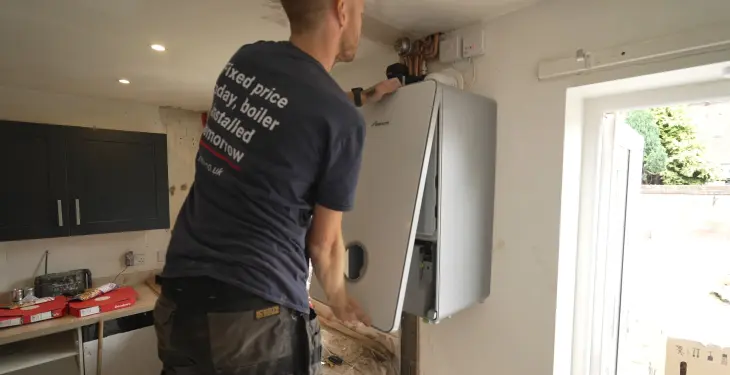



Written by Stephen Day
Gas Safe Engineer
Updated: 30th May, 2025
Boiler settings play a crucial role in the performance and efficiency of your heating system, but many homeowners are unsure about how to adjust them to optimise their boiler's performance. Our guide explores the different boiler settings, including temperature, pressure, and timing, and provides practical advice on how to adjust them to improve your boiler's efficiency and save money on your ener
Get a new boiler quote, save up to £550 per year (0% APR available).
Exploring boiler settings is essential for homeowners and property managers alike, as it can lead to improved heating efficiency, reduced energy bills, and increased safety. It's crucial to understand how your boiler works and the various settings available to optimise its performance.
Whether you have a conventional or combi boiler system, making adjustments to the settings can have a notable impact on the overall comfort levels in your living spaces and the efficiency of your heating system.
Get a quote in 60 seconds, fitted as fast as next day!
0% APR finance available.
Understanding the optimal temperature settings for your boiler is key. For instance, setting your boiler at 65°C can provide a good balance between warmth and efficiency. This temperature is also vital for preventing the growth of bacteria that can cause diseases like Legionella.
Proper adjustment of your boiler system, as well as making informed decisions about upgrading or repairing it when necessary, can significantly contribute to the longevity of your unit and promote a comfortable living environment.
Optimising boiler settings can lead to improved heating efficiency and safety.
Setting your boiler at around 65°C helps balance warmth and energy efficiency.
Periodic maintenance, necessary upgrades, and repairs ensure your boiler runs smoothly.
Boiler settings play a crucial role in maintaining optimal heating performance and energy efficiency. In this section, we will explore the role of the thermostat, how to read dials and digital displays, and an overview of boiler controls.
A thermostat is an essential component of any heating system. It serves as the central control device, communicating with the boiler and dictating when it needs to generate heat. The thermostat measures the ambient temperature and compares it with the desired temperature set by the user. If the actual temperature is lower, the thermostat sends a signal to the boiler to start its heating cycle. To conserve energy and maintain desired comfort levels, regular thermostat adjustments can be a useful tool.
Boiler dials and digital displays vary in design and functionality, but they generally serve the same purpose. These displays help the user understand and control essential aspects of the boiler's operation.
Temperature setting: Boilers often have a dial or digital display to set the target temperature for the system. The ideal temperature varies based on individual preferences, the type of dwelling, and weather conditions, but generally falls between 65°F (18°C) and 75°F (24°C).
Boiler pressure: A gauge is usually included to show the boiler’s water pressure. Keeping an eye on the pressure is essential for preventing boiler issues and maintaining efficiency. The normal operating pressure range for most boilers is 1.0 - 1.5 bar.
Mode selection: Some boilers have a mode control, allowing users to switch between heating modes, timed heating schedules, or a combination of both.
Boiler controls encompass a wide array of devices and settings that enable users to optimise energy consumption and heating efficiency. Key controls include:
Timer: Timers are typically used to schedule the heating system, turning it on and off at specific times. Programming the timer to match your daily routine can save energy and money.
Programmer: A programmer offers increased control over the heating system, enabling users to set different temperature levels and heating schedules for various parts of the day. This control allows for tailored heating that aligns with the user's lifestyle and needs.
Smart thermostats: These advanced devices can connect to the internet and be controlled remotely through mobile apps or web-based platforms. Smart thermostats offer additional energy-saving features, such as learning algorithms for automatic temperature adjustments based on user behaviour and schedules.
In summary, understanding boiler settings and controls is critical for maintaining optimal energy efficiency and comfort. By familiarising yourself with thermostats, dials, and digital displays, you can effectively regulate your heating system and save money on heating bills.
When it comes to optimising your boiler for efficiency, the primary goal is to adjust the settings that affect energy use. One such setting is the flow temperature. By lowering the flow temperature setting, you can increase the boiler's efficiency by 10% to 25%. This won't only help conserve energy but also reduce your energy bills.
Moreover, maintaining your boiler ensures that it functions optimally; annual servicing, cleaning, and filter replacement are essential aspects of boiler maintenance. Keep in mind that boilers tend to lose efficiency over time. Thus, replacing older boilers with newer, A-rated boilers boasting at least 92% ErP efficiency can be a worthwhile investment.
Efficient energy use plays a critical role in reducing the environmental impact and energy costs. By using a heating system with higher efficiency, you contribute to lower fossil fuel consumption, ultimately decreasing greenhouse gas emissions. In addition, utilising energy-efficient heating systems can help curb energy bills, making them more affordable for the average household.
Room temperature is another crucial aspect of energy conservation. A well-insulated home retains heat better and requires less energy to maintain an optimal temperature. As a result, the boiler doesn't need to work as hard, which improves its efficiency and extends its lifespan.
Furthermore, setting thermostats and radiator valves to appropriate levels can maintain desired room temperatures and prevent overheating of certain areas. This approach allows you to reduce energy consumption without sacrificing comfort.
In conclusion, enhancing boiler efficiency, adopting energy-efficient practices, and managing room temperatures effectively contribute to a more sustainable heating system and energy use. Implementing these strategies pays off not only in reduced environmental impact but also in significant cost savings.
Combi boilers, or combination boilers, are the most common type of boiler found in UK homes. They are highly efficient and provide both central heating and hot water on demand. A key aspect of combi boilers is their temperature settings, which have a direct impact on energy efficiency and warmth in the home.
The flow temperature of a combi boiler can be adjusted to optimise your heating system for efficiency and comfort. Typically, setting the temperature between 60-80°C is recommended, depending on your individual needs and preferences. Keep in mind that a higher temperature setting will heat a room faster, but it will never exceed the set temperature on the thermostat.
Modern combi boilers are often condensing boilers, designed to capture and reuse heat from the exhaust gases. These boilers function through a closed system, making them even more energy-efficient and environmentally friendly.
Condensing combi boilers work by employing a heat exchanger to capture additional heat from the flue gases before they are expelled through the flue system. This captured heat is then used to pre-heat the incoming water, increasing the overall efficiency of the boiler. They can achieve efficiencies of up to 90%, significantly reducing fuel consumption and heating bills.
To maximise the benefits of a condensing combi boiler, it is essential to properly maintain and adjust the boiler controls. This includes regular servicing, adjusting the boiler temperature according to seasonal changes, and ensuring that the system is free from any trapped air or blockages.
By understanding and managing the temperature settings and utilising a condensing combi boiler, you will have an efficient, cost-effective, and reliable heating system in your home.
Flow temperature plays a significant role in determining heating bills. It refers to the temperature of water circulating in the radiators and underfloor heating systems. The higher the flow temperature, the more energy your boiler consumes, leading to increased heating costs. Conversely, lower flow temperatures can help maintain a comfortable environment while consuming less energy.
Additionally, proper boiler settings and control systems can contribute to reduced energy consumption. For instance, a room thermostat helps prevent your heating system from using more fuel than required. It works by turning the heating on until it reaches the programmed temperature and off once the temperature drops below this threshold. Thermostats are typically set between 18°C and 21°C for optimal balance between comfort and efficiency.
One efficient way to save on heating bills is by lowering the flow temperature of your boiler. A study by the Heating and Hotwater Industry Council (HHIC) indicates that reducing a combi boiler's radiator flow can lead to 6-8% savings on gas bills. Moreover, having smart controls that allow you to adjust time and temperature settings through your mobile phone not only adds convenience but also achieves a 6% reduction in gas consumption.
When managing heating costs, it's essential to consider the age of your boiler and the heating controls. Updating an outdated boiler can help you save on bills, as newer models are more energy-efficient. However, the cost of purchasing and installing a new boiler may not always be cost-effective.
Here are a few tips to reduce your heating bills:
Adjust the thermostat temperature on milder days
Use smart controls to customise settings and sense occupants' presence
Insulate your home to prevent heat loss
Regularly service your boiler to maintain efficiency
By applying these measures, you can effectively control and lower your heating bills while maintaining a comfortable living environment.
When exploring boiler settings, it is essential to consider the safety aspects associated with their operation. In this section, we will discuss two primary safety concerns: preventing the growth of legionella bacteria and knowing when to call a heating engineer.
Legionella bacteria can pose a serious health risk in boiler systems, particularly in hot water systems. Legionella thrives in stagnant water between 20-50°C; therefore, it is important to maintain proper temperature settings when operating your boiler system.
To minimise the risk of legionella bacteria growth, consider the following steps:
Regularly run your boiler: Running your boiler ensures the circulation of water, preventing stagnation and inhibiting bacterial growth.
Monitor water temperature: Maintain hot water temperature in your boiler system between 50-60°C. It is crucial to keep the temperature above 50°C to kill off any bacteria.
Regularly clean and flush: Periodically flush your boiler system and, if possible, clean the associated pipework. This will help remove any build-up of bacteria and reduce the risk of legionella.
Insulate pipework: Proper insulation not only prevents heat loss but can also reduce the potential for bacterial growth by keeping the pipework at the desired temperature level.
Attempting to modify boiler settings or repair issues without the appropriate expertise can introduce safety hazards. It is vital to know when you should call a professional heating engineer for assistance. The following situations may warrant the help of an expert:
Installation or modification: When installing a new boiler or making significant modifications to an existing system, it is crucial to have a heating engineer involved in the initial stages, guaranteeing that every aspect of the installation is compliant with safety regulations.
Servicing and maintenance: Regular servicing is necessary to maintain your boiler's efficiency while ensuring the safety of its operation. Many manufacturers have servicing intervals specified in their manuals; however, as a general rule, it is recommended to have your boiler serviced yearly by a qualified gas engineer.
Emergencies and malfunctions: If you experience unexpected boiler shutdowns, leaks, pressure issues, or unfamiliar noises, it is important to consult a heating engineer to assess and rectify the problem.
Safety should be a priority when operating boiler systems. By taking preventative measures against legionella bacteria and knowing when to seek professional help from a heating engineer, you can ensure the safe and efficient operation of your boiler.
Last updated: 30th May, 2025

Written by Stephen Day
Gas Safe Engineer at iHeat
Stephen Day is a Gas Safe registered and FGAS certified engineer with over 20 years of hands-on experience in the heating, cooling, and renewable energy industry, specialising in boiler installations, air conditioning, and heat pump systems.
LinkedInArticles by Stephen Day are reviewed by iHeat’s technical team to ensure accuracy and reliability.

22nd December, 2025
Based on data from over 7000 boiler installations completed by iHeat in the past 12 months...
 Read Article
Read Article

22nd December, 2025
Here’s a quick roundup of the best combi boilers for 2026.
 Read Article
Read Article

22nd December, 2025
When your old boiler breaks down and it comes time to replace it with a new one, it might...
 Read Article
Read Article
No obligation. Takes less than 60 seconds.